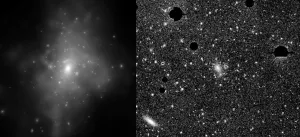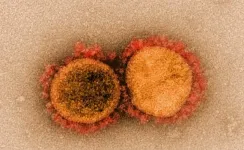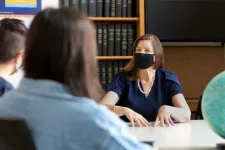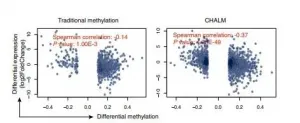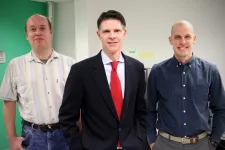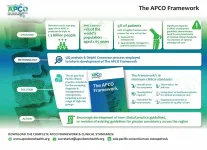(Press-News.org) A combination of observational data and sophisticated computer simulations have yielded advances in a field of astrophysics that has languished for half a century. The Dark Energy Survey, which is hosted by the U.S. Department of Energy's Fermi National Accelerator Laboratory, has published a burst of new results on what's called intracluster light, or ICL, a faint type of light found inside galaxy clusters.
The first burst of new, precision ICL measurements appeared in a paper published in The Astrophysical Journal in April 2019. Another appeared more recently in Monthly Notices of the Royal Astronomical Society. In a surprise finding of the latter, DES physicists discovered new evidence that ICL might provide a new way to measure a mysterious substance called dark matter.
The source of ICL appears to be rogue stars, those not gravitationally bound to any galaxy. The ICL has long been suspected of possibly being a significant component of clusters of galaxies, but its faintness makes it difficult to measure. No one knows how much there is or to what extent it has spread through galaxy clusters.
"Observationally we discovered that intracluster light is a pretty good radial tracer of dark matter. That means that where intracluster light is relatively bright, the dark matter is relatively dense," said Fermilab scientist Yuanyuan Zhang, who led both studies. "Just measuring the ICL itself is pretty exciting. The dark matter part is a serendipitous discovery. It's not what we expected."
Although invisible, dark matter accounts for most matter in the universe. What dark matter consists of stands as one of the major mysteries of modern cosmology. Scientists know only that it differs greatly from the normal matter consisting of the protons, neutrons and electrons that dominate everyday life.
But ICL, not dark matter, was initially on the research team's agenda. Most astrophysicists measure intracluster light at the center of a galaxy cluster, where it is brightest and most abundant.
"We went very far away from the centers of the galaxy clusters, where the light is really faint," Zhang said. "And the farther away from the center we went, the more difficult the measurement became."
Nevertheless, the DES collaborators managed to come away with the most radially extended measurement of ICL ever.
The team used weak gravitational lensing to compare the radial distribution of the ICL -- how it changes over distance from the center of a cluster -- to the radial distribution of the mass of a galaxy cluster. Weak lensing is a dark-matter-sensitive method of measuring the mass of a galaxy or cluster. It occurs when the gravity of a foreground star or cluster bends the light from a more distant galaxy, distorting its apparent shape.
It turned out observationally that ICL reflects the distribution of both the total visible mass of a galaxy cluster and, possibly, the distribution of the invisible dark matter.
"We did not expect to find such a tight connection between these radial distributions, but we did," said scientist Hillysson Sampaio-Santos, the lead author of the new paper.
Comparing observations with simulations
To gain more insight, the team used a sophisticated computer simulation to study the relationship between ICL and dark matter. They found that the radial profiles between the two phenomena in the simulation didn't agree with the observational data. In the simulation, "the ICL radial profile was not the best component to trace dark matter," said Sampaio-Santos, who is with the National Observatory in Rio de Janeiro, Brazil.
Zhang noted that it's too soon to tell exactly what caused the conflict between observation and simulation.
"If the simulation didn't get it right, it could mean that the simulated intracluster light is produced at a slightly different time than in observations. The simulated stars didn't have enough time to wander around and start to trace dark matter," she said.
Sampaio-Santos noted that further ICL studies could yield insights into the dynamics occurring inside galaxy clusters, including interactions that gravitationally release some of their stars, allowing them to wander around.
"I'm planning to study the intracluster light and the effects of relaxation," or spreading out, he said. For example, some clusters have merged together. These merged clusters should have different properties of ICL compared to clusters that are relaxed.
Enhancing signals in noisy data sets
The ICL that the team measured is about a hundred to a thousand times fainter than what DES scientists normally attempt. That means the team had to deal with a lot of noise and contamination in the signal.
The technical aspect of the feat was challenging, Zhang said, "but because we had quite a bit of data from the Dark Energy Survey, we were able to cancel out a lot of noise to do this kind of measurement. It's statistical averaging."
Astrophysicists typically make ICL measurements using a handful of galaxy clusters at a time.
"That's a great way to get information about the individual systems," Zhang said.
To get the bigger picture and to beat down the noise, the DES team statistically averaged about 300 galaxy clusters in the first study and more than 500 clusters in the second. All of them are a couple of billion light-years from Earth.
Teasing the signal from the noise of each cluster takes a lot of data, which is exactly what the DES has generated. In early 2019, DES completed its six-year mission of observing hundreds of millions of distant galaxies in the southern skies and publicly issued its second data release in mid-January.
The ICL measurements probe clusters that are up to 3.3 billion light-years from Earth. In future studies, Zhang would like to study the redshift evolution of ICL -- how it changes with cosmic time.
"My dream is to go all the way to redshift one -- 10 billion light-years," Zhang said. "Studies say that's when the ICL has just started to evolve."
Going that far would enable scientists to see ICL building over time.
"But that's really hard because it's three times as far as the distance of our latest measurements, so everything is going to be extremely faint there," she said.
INFORMATION:
The Dark Energy Survey is a collaboration of more than 300 scientists from 25 institutions in six countries. For more information about the survey, please visit the experiment's website.
Funding for the DES Projects has been provided by the U.S. Department of Energy, the U.S. National Science Foundation, the Ministry of Science and Education of Spain, the Science and Technology Facilities Council of the United Kingdom, the Higher Education Funding Council for England, the National Center for Supercomputing Applications at the University of Illinois at Urbana-Champaign, the Kavli Institute of Cosmological Physics at the University of Chicago, Funding Authority for Studies and Projects in Brazil, Carlos Chagas Filho Foundation for Research Support of the State of Rio de Janeiro, Brazilian National Council for Scientific and Technological Development and the Ministry of Science, Technology and Innovation, the German Research Foundation and the collaborating institutions in the Dark Energy Survey.
Fermilab is supported by the Office of Science of the U.S. Department of Energy. The Office of Science is the single largest supporter of basic research in the physical sciences in the United States and is working to address some of the most pressing challenges of our time. For more information, visit science.energy.gov.
As surgeons balance the need to control their patients' post-surgery pain with the risk that a routine operation could become the gateway to long-term opioid use or addiction, a new study shows the power of an approach that takes a middle way.
In a new letter in JAMA Surgery, a team from Michigan Medicine at the University of Michigan reports on findings from a study of 620 patients who had surgery in hospitals across Michigan, had their painkiller use tracked, and took surveys within one to three months after their operations.
Half of the patients received pre-surgery counseling that emphasized non-opioid pain treatment as their first option. Some patients in this group received small, "just in case" prescriptions, but a third of them didn't receive any opioid prescription ...
LA JOLLA--A new study led by scientists at La Jolla Institute for Immunology (LJI) suggests that T cells try to fight SARS-CoV-2 by targeting a broad range of sites on the virus--beyond the key sites on the virus's spike protein. By attacking the virus from many angles, the body has the tools to potentially recognize different SARS-CoV-2 variants.
The new research, published January 27, 2021 in Cell Report Medicine, is the most detailed analysis so far of which proteins on SARS-CoV-2 stimulate the strongest responses from the immune system's "helper" CD4+ T cells and "killer" CD8+ T cells.
"We ...
INDIANAPOLIS--Researchers at the Indiana University Melvin and Bren Simon Comprehensive Cancer Center have identified how breast cancer cells hide from immune cells to stay alive. The discovery could lead to better immunotherapy treatment for patients.
Xinna Zhang, PhD, and colleagues found that when breast cancer cells have an increased level of a protein called MAL2 on the cell surface, the cancer cells can evade immune attacks and continue to grow. The findings are published this month in The Journal of Clinical Investigation and featured on the journal's cover.
The lead author of the study, Zhang is a member of the ...
Members of Syracuse University's College of Arts and Sciences are shining new light on an enduring mystery--one that is millions of years in the making.
A team of paleontologists led by Professor Cathryn Newton has increased scientists' understanding of whether Devonian marine faunas, whose fossils are lodged in a unit of bedrock in Central New York known as the Hamilton Group, were stable for millions of years before succumbing to waves of extinctions.
Drawing on 15 years of quantitative analysis with fellow professor Jim Brower (who died in 2018), Newton has continued to probe the structure of these ancient fossil communities, among the most renowned on Earth.
The group's findings, reported by the Geological Society of America (GSA), provide critical ...
Irvine, CA - January 27, 2021 - A new University of California, Irvine-led study finds a new method for identifying biomarkers may aid in early cancer diagnosis. The study focused on lung cancer, however the Cell Heterogeneity-Adjusted cLonal Methylation (CHALM) method has been tested on aging and Alzheimer's diseases as well and is expected to be effective for studying other diseases.
"We found the CHALM method may be a valuable tool in helping researchers to identify more reliable differentially methylated genes from sequence-based methylation data," ...
Doctors are increasingly using genetic signatures to diagnose diseases and determine the best course of care, but using DNA sequencing and other techniques to detect genomic rearrangements remains costly or limited in capabilities. However, an innovative breakthrough developed by researchers at Virginia Commonwealth University Massey Cancer Center and the VCU Department of Physics promises to diagnose DNA rearrangement mutations at a fraction of the cost with improved accuracy.
Led by VCU physicist Jason Reed, Ph.D., the team developed a technique that combines a process called digital polymerase chain reaction (dPCR) with high-speed atomic force microscopy (HSAFM) to create an image with such nanoscale resolution that users can measure differences in ...
Historically redlined neighborhoods are more likely to have a paucity of greenspace today compared to other neighborhoods. The study by researchers at Columbia University Mailman School of Public Health and the University of California, Berkeley and San Francisco, demonstrates the lasting effects of redlining, a racist mortgage appraisal practice of the 1930s that established and exacerbated racial residential segregation in the United States. Results appear in Environmental Health Perspectives.
In the 1930s, the Home Owners' Loan Corporation (HOLC) assigned risk grades to neighborhoods across the country based on racial demographics and other factors. "Hazardous" areas--often those whose residents included people ...
LAWRENCE -- For at least a century, ecologists have wondered at the tendency for populations of different species to cycle up and down in steady, rhythmic patterns.
"These cycles can be really exaggerated -- really huge booms and huge busts -- and quite regular," said Daniel Reuman, professor of ecology & evolutionary biology at the University of Kansas and senior scientist at the Kansas Biological Survey. "It attracted people's attention because it was kind of mysterious. Why would such a big thing be happening?"
A second observation in animal populations ...
(Boston)--Researchers from Boston University School of Medicine (BUSM) have identified proteins that are essential for the viability of whole genome doubled tumor cells, yet non-essential to normal cells that comprise the majority of human tissue.
"Exploiting these vulnerabilities represents a highly significant and currently untapped opportunity for therapeutic intervention, particularly because whole genome doubling is a distinguishing characteristic of many tumor types," said corresponding author Neil J. Ganem, PhD, associate professor of pharmacology and medicine, section of hematology and medical oncology, at Boston University School of Medicine (BUSM).
The vast majority of human cells are diploid, meaning that they possess two copies of each ...
The Asia Pacific Consortium on Osteoporosis (APCO) has today launched the first pan-Asia Pacific clinical practice standards for the screening, diagnosis, and management of osteoporosis, targeting a broad range of high-risk groups.
Published in Osteoporosis International today, 'The APCO Framework' comprises 16 minimum clinical standards set to serve as a benchmark for the provision of optimal osteoporosis care in the region.
Developed by APCO members representing key osteoporosis stakeholders, and multiple medical and surgical specialities, this set of clear, concise, relevant and pragmatic clinical standards aims to support national societies, guidelines development authorities, and health care policy makers with ...
